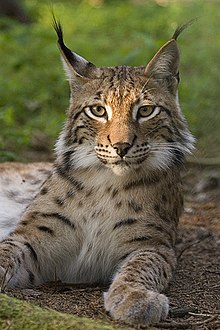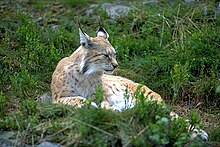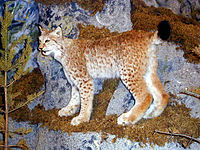Eurasian lynx
| Eurasian Lynx[1] | |
|---|---|

| |
| Scientific classification | |
| Kingdom: | |
| Phylum: | |
| Class: | |
| Order: | |
| Family: | |
| Genus: | |
| Species: | L. lynx
|
| Binomial name | |
| Lynx lynx (Linnaeus, 1758)
| |

| |
| Eurasian lynx range | |
The Eurasian lynx (Lynx lynx) is a medium-sized cat native to European and Siberian forests, where it is one of the predators. The Eurasian lynx is the biggest of the lynxes, ranging in length from 80 to 130 cm (32 to 51 in) and standing about 70 cm (28 in) at the shoulder. Males usually weigh from 18 to 30 kg (40 to 66 lb) and females weigh 18.1 kg (40 lb) on average.[3] It has grey to reddish fur with black spots. The pattern of the fur is variable; lynxes with heavily spotted fur may exist close to conspecifics with plain fur. The Eurasian lynx is mainly nocturnal and lives solitarily as an adult. Moreover, the sounds this lynx makes are very quiet and seldom heard, so the presence of the species in an area may go unnoticed for years. Remnants of prey or tracks on snow are usually observed long before the animal is seen.
Lynxes prey on hares, rabbits, rodents, wild boar, chamois, foxes, roe deer and reindeer. As with other cats, trying on larger prey presents a risk to the animal. The main method of hunting is stalking, sneaking and jumping on prey. In winter certain snow conditions make this harder and the animal may be forced to switch to larger prey. The European lynx likes rugged forested country providing plenty of hideouts and stalking opportunities. The hunting area of an average lynx is from 20 to 60 km² and it can tread more than 20 km during one night.
Status
Once this cat was quite common in all of Europe. By the middle of the 19th century, it had become extinct in most countries of Central and Western Europe. Recently, there have been successful attempts to reintroduce lynx to forests.
Status of the Eurasian lynx in various countries and regions:
- Carpathian Mountains: About 2,800 lynxes live in this mountain range in the Czech Republic, Poland, Romania, Slovakia and Serbia.[4] It is the largest continuous Eurasian lynx population west of the Russian border.
- Romania: Most of the Carpathian population is found here, where numbers exceed 2,000, which is the largest population in Europe.[citation needed] Limited hunting is permitted but the population is stable.
- Balkan peninsula: In Serbia, Republic of Macedonia, Albania and Greece there are about 100 lynxes, the largest numbers in remote hills of western Macedonia.[5]
- Britain: It was thought that lynx had died out in Britain either about 10,000 years ago, after the ice had retreated, or about 4,000 years ago, during cooler and wetter climate change. However, carbon dating of lynx skulls taken from the National Museums of Scotland and the Craven caves in North Yorkshire show they lived in Britain between 80 and 425 AD.[6] A native name for the animal, lox, existed in Old English.[7]
- Central Asia: The European lynx is also native to the Chinese provinces of Gansu, Qinghai, Sichuan and Shaanxi, as well as to Iran, Mongolia, Kazakhstan, Uzbekistan, Turkmenistan, Kyrgyzstan, Tajikistan, and to Northern Pakistan (Kashmir).
- Czech Republic: In Bohemia, lynx was exterminated in the 19th century (1830-1890) and in Moravia probably at the turn of the 19th and 20th century. After 1945 migration from Slovakia created a small and unstable population in Moravia. In the 1980s, almost 20 specimens were imported from Slovakia and reintroduced in the Šumava area. At the beginning of 2006 , the population of lynx in the Czech Republic was estimated at 65-105 individuals. Hunting is prohibited, but lynx is often threatened by poachers.
- Dinaric Alps and Julian Alps: Slovenia, Croatia and Bosnia and Herzegovina are home to between 130 and 200 lynxes.[4][8] The Eurasian lynx was considered extinct in these countries since the beginning of the 20th century. However, a successful resettlement project begun in Slovenia in 1973. Today, lynxes can be found in the Slovenian Alps and in the Croatian regions of Gorski Kotar and Velebit, spanning over the Dinaric Alps and over the Dinara Mountain into western Bosnia and Herzegovina. Croatia's Plitvice Lakes National Park is home to several pair of lynxes. In the three countries, the Eurasian lynx is listed as an endangered species and protected by law. Realistic population estimates are of 40 lynxes in Slovenia, 100-120 in Croatia and about 40 in Bosnia and Herzegovina. The Croatian massif Risnjak in Risnjak National Park probably got its name from the Croatian word for lynx, ris.
- Fennoscandia: Fennoscandian lynxes were close to extinction in the 1930s-1950s but increased again thanks to protection. In the meantime protective hunting for lynxes has been legalised again. The numbers are still on a slow increase. Lynx is the only non-domestic feline in Scandinavia.
- Finland: 1,100 to 1,200 specimens (2006 est.) [10]
- Norway: Lynx is found in stable populations throughout Norway except for the southwestern counties, where they are only found sporadically. The national goal of 65 lynxes bred was reached in 2007, with 69 to 74 registered lynxes bred. The population was estimated at 409-439 specimens.[11]
- Sweden: Sweden had an estimated population of about 1,400 lynxes in 2006. The hunt is controlled by government agencies.[12] Hunters who wish to partake in the hunt for lynx must register for the so-called protective hunt, which takes place in March. There are only a few animals to be shot in each region depending on how many lynxes there are and/or how the Reindeer herding is affected. Every shot animal and shooting location is controlled by the County Administration and the carcass is sent away for analysis to National Veterinary Institute. The shooter himself may keep the skin, if a microchip or transponder is attached by the local police authority. The skull of the shot animal can be sent back to the shooter for a fee of about €70. No more than 75 animals in 20 regions may be shot in 2007, an increase from 51 in 2006 (always about 5 % of the population). In 2006 there were 41 lynxes killed outside hunting, 31 in traffic accidents.
- France: Lynx was exterminated about the year 1900 but later reintroduced to the Vosges and Pyrenees.
- Germany: Lynx was exterminated in 1850 . It was reintroduced to the Bavarian Forest and the Harz in the 1990s. In 2002 the first birth of wild lynxes on German territory was announced: a couple of lynxes in the Harz National Park gave birth to the young. Also present in the Eifel, probably from France. And in the Vogelsberg Mountains in Hesse.

- Latvia: According to the estimate made in 2005, about 700 hundred animals inhabit areas in Courland and Vidzeme.[13]
- Netherlands: Lynx is extinct in the Netherlands (since the Middle Ages). Although there were some sightings, they probably stem from captive bred lynx escaped or released to the wild.[14]
- Poland: There are about 1,000 lynxes in the Białowieża Forest and the Tatra mountains.[citation needed]
- Russia: More than 90% of all Eurasian Lynxes live in the forests of Siberia. They are distributed from the western borders of Russia to the Pacific island of Sakhalin.
- Slovakia: Lynx is native to forested areas in Central and East Slovakia. Lynx in Slovakia lives mainly in mixed forests at altitudes from 800 to 1,000 m. Lynx could be found in many national parks of Slovakia and other protected areas.[15][16]
- Switzerland: Lynx was extinct in 1915 but reintroduced in 1971. From here lynx migrated to Austria, where they had been exterminated as well.[citation needed]
- Turkey: As "the fate of Turkey's wildlife lies with various governmental bodies holding often conflicting agendas and handicapped by a lack of skilled personnel and funding" unfortunately "there are no estimates of the number" of Eurasian lynx living in Turkey and possibly their number is declining due to legal hunting of the animal from August to the end of March every year. [17][18]
Subspecies

The following are the recognized subspecies of the Eurasian lynx. Others have been proposed, but are now considered to be synonyms for these.[1]
- Lynx lynx lynx, Scandinavia, Central Europe, Eastern Europe and western Serbia, Caucasus, Siberia, Mongolia, Northern China, Korea
- Lynx lynx isabellinus, Central Asia
- Lynx lynx kozlovi, Central Siberia
- Lynx lynx sardiniae, Sardinia (extinct)
- Lynx lynx stroganovi, Amur region
References
- ^ a b Wozencraft, W. C. (2005). "Order Carnivora". In Wilson, D. E.; Reeder, D. M. (eds.). Mammal Species of the World: A Taxonomic and Geographic Reference (3rd ed.). Johns Hopkins University Press. p. 541. ISBN 978-0-8018-8221-0. OCLC 62265494.
- ^ Template:IUCN2006 The database entry includes justification for why this species is near threatened.
- ^ "Eurasian lynx". Peter Jackson. 24 April 1997. Retrieved 2007-05-28.
{{cite web}}: Check date values in:|date=(help) - ^ a b "Large Carnivore Initiative for Europe Species fact sheet - Lynx lynx". Large Carnivore Initiative for Europe. no date. Retrieved May 28.
{{cite web}}: Check date values in:|accessdate=and|date=(help); Unknown parameter|accessyear=ignored (|access-date=suggested) (help) - ^ "Action urged to save Balkan lynx". BBC. 3 November 2006. Retrieved May 28.
{{cite web}}: Check date values in:|accessdate=and|date=(help); Unknown parameter|accessyear=ignored (|access-date=suggested) (help) - ^ "The bone-man's legacy"; New Scientist 11 August 2007; pp48-49
- ^ Online Etymology Dictionary
- ^ "World of Animals at Plitvice Lakes". Plitvice Lakes National Park World of Animals.
- ^ "Estonia - 3. Size & trend". Eurasian Lynx Online Information System for Europe. Retrieved 2007-05-28.
- ^ "Suurpetojen lukumäärä ja lisääntyminen vuonna 2005". Finnish Game and Fisheries Research Institute. 7 August 2006. Retrieved 2007-06-13.
{{cite web}}: Check date values in:|date=(help) - ^ "Lynx". State of the Environment Norway. 19 June 2006. Retrieved 2007-10-06.
{{cite web}}: Check date values in:|date=(help) - ^ "Swedish Environmental Protection Agency & Council For Predator Issues".
- ^ "Latvia". Eurasian Lynx Online Information System for Europe. Retrieved 2008-01-22.
- ^ "ELOIS - Introduction". Eurasian Lynx Online Information System for Europe. no date. Retrieved May 28.
{{cite web}}: Check date values in:|accessdate=and|date=(help); Unknown parameter|accessyear=ignored (|access-date=suggested) (help) - ^ "Natura 2000 Sites - Rys ostrovid" (in Slovak). State Nature Conservancy SR. no date. Retrieved 2007-05-28.
{{cite web}}: Check date values in:|date=(help) - ^ "Slovakia (SK)". Eurasian Lynx Online Information System for Europe. no date. Retrieved 2007-05-28.
{{cite web}}: Check date values in:|date=(help) - ^ Johnson, Kirk (2002). "The Status of Mammalian Carnivores in Turkey". University of Michigan.
{{cite web}}: Unknown parameter|month=ignored (help) - ^ "European Lynx Specialists Conference". 1991.
External links
- Eurasian Lynx Online Information System for Europe
- About the Eurasian Lynx from the Wild Cats: Status Survey and Conservation Action Plan
- Eurasian Lynx on the IUCN Red List of Threatened Species
- Eurasian Lynx at the World Conservation Monitoring Centre
- Large Carnivore Initiative for Europe
- Balkan Lynx Conservation Compendium

